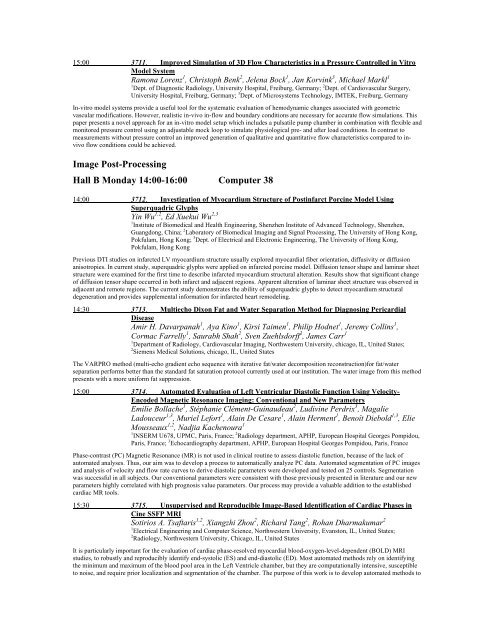ELECTRONIC POSTER - ismrm
ELECTRONIC POSTER - ismrm
ELECTRONIC POSTER - ismrm
Create successful ePaper yourself
Turn your PDF publications into a flip-book with our unique Google optimized e-Paper software.
15:00 3711. Improved Simulation of 3D Flow Characteristics in a Pressure Controlled in Vitro<br />
Model System<br />
Ramona Lorenz 1 , Christoph Benk 2 , Jelena Bock 1 , Jan Korvink 3 , Michael Markl 1<br />
1 Dept. of Diagnostic Radiology, University Hospital, Freiburg, Germany; 2 Dept. of Cardiovascular Surgery,<br />
University Hospital, Freiburg, Germany; 3 Dept. of Microsystems Technology, IMTEK, Freiburg, Germany<br />
In-vitro model systems provide a useful tool for the systematic evaluation of hemodynamic changes associated with geometric<br />
vascular modifications. However, realistic in-vivo in-flow and boundary conditions are necessary for accurate flow simulations. This<br />
paper presents a novel approach for an in-vitro model setup which includes a pulsatile pump chamber in combination with flexible and<br />
monitored pressure control using an adjustable mock loop to simulate physiological pre- and after load conditions. In contrast to<br />
measurements without pressure control an improved generation of qualitative and quantitative flow characteristics compared to invivo<br />
flow conditions could be achieved.<br />
Image Post-Processing<br />
Hall B Monday 14:00-16:00 Computer 38<br />
14:00 3712. Investigation of Myocardium Structure of Postinfarct Porcine Model Using<br />
Superquadric Glyphs<br />
Yin Wu 1,2 , Ed Xuekui Wu 2,3<br />
1 Institute of Biomedical and Health Engineering, Shenzhen Institute of Advanced Technology, Shenzhen,<br />
Guangdong, China; 2 Laboratory of Biomedical Imaging and Signal Processing, The University of Hong Kong,<br />
Pokfulam, Hong Kong; 3 Dept. of Electrical and Electronic Engineering, The University of Hong Kong,<br />
Pokfulam, Hong Kong<br />
Previous DTI studies on infarcted LV myocardium structure usually explored myocardial fiber orientation, diffusivity or diffusion<br />
anisotropies. In current study, superquadric glyphs were applied on infarcted porcine model. Diffusion tensor shape and laminar sheet<br />
structure were examined for the first time to describe infarcted myocardium structural alteration. Results show that significant change<br />
of diffusion tensor shape occurred in both infarct and adjacent regions. Apparent alteration of laminar sheet structure was observed in<br />
adjacent and remote regions. The current study demonstrates the ability of superquadric glyphs to detect myocardium structural<br />
degeneration and provides supplemental information for infarcted heart remodeling.<br />
14:30 3713. Multiecho Dixon Fat and Water Separation Method for Diagnosing Pericardial<br />
Disease<br />
Amir H. Davarpanah 1 , Aya Kino 1 , Kirsi Taimen 1 , Philip Hodnet 1 , Jeremy Collins 1 ,<br />
Cormac Farrelly 1 , Saurabh Shah 2 , Sven Zuehlsdorff 2 , James Carr 1<br />
1 Department of Radiology, Cardiovascular Imaging, Northwestern University, chicago, IL, United States;<br />
2 Siemens Medical Solutions, chicago, IL, United States<br />
The VARPRO method (multi-echo gradient echo sequence with iterative fat/water decomposition reconstruction)for fat/water<br />
separation performs better than the standard fat saturation protocol currently used at our institution. The water image from this method<br />
presents with a more uniform fat suppression.<br />
15:00 3714. Automated Evaluation of Left Ventricular Diastolic Function Using Velocity-<br />
Encoded Magnetic Resonance Imaging: Conventional and New Parameters<br />
Emilie Bollache 1 , Stéphanie Clément-Guinaudeau 2 , Ludivine Perdrix 3 , Magalie<br />
Ladouceur 1,3 , Muriel Lefort 1 , Alain De Cesare 1 , Alain Herment 1 , Benoît Diebold 1,3 , Elie<br />
Mousseaux 1,2 , Nadjia Kachenoura 1<br />
1 INSERM U678, UPMC, Paris, France; 2 Radiology department, APHP, European Hospital Georges Pompidou,<br />
Paris, France; 3 Echocardiography department, APHP, European Hospital Georges Pompidou, Paris, France<br />
Phase-contrast (PC) Magnetic Resonance (MR) is not used in clinical routine to assess diastolic function, because of the lack of<br />
automated analyses. Thus, our aim was to develop a process to automatically analyze PC data. Automated segmentation of PC images<br />
and analysis of velocity and flow rate curves to derive diastolic parameters were developed and tested on 25 controls. Segmentation<br />
was successful in all subjects. Our conventional parameters were consistent with those previously presented in literature and our new<br />
parameters highly correlated with high prognosis value parameters. Our process may provide a valuable addition to the established<br />
cardiac MR tools.<br />
15:30 3715. Unsupervised and Reproducible Image-Based Identification of Cardiac Phases in<br />
Cine SSFP MRI<br />
Sotirios A. Tsaftaris 1,2 , Xiangzhi Zhou 2 , Richard Tang 2 , Rohan Dharmakumar 2<br />
1 Electrical Engineering and Computer Science, Northwestern University, Evanston, IL, United States;<br />
2 Radiology, Northwestern University, Chicago, IL, United States<br />
It is particularly important for the evaluation of cardiac phase-resolved myocardial blood-oxygen-level-dependent (BOLD) MRI<br />
studies, to robustly and reproducibly identify end-systolic (ES) and end-diastolic (ED). Most automated methods rely on identifying<br />
the minimum and maximum of the blood pool area in the Left Ventricle chamber, but they are computationally intensive, susceptible<br />
to noise, and require prior localization and segmentation of the chamber. The purpose of this work is to develop automated methods to
















